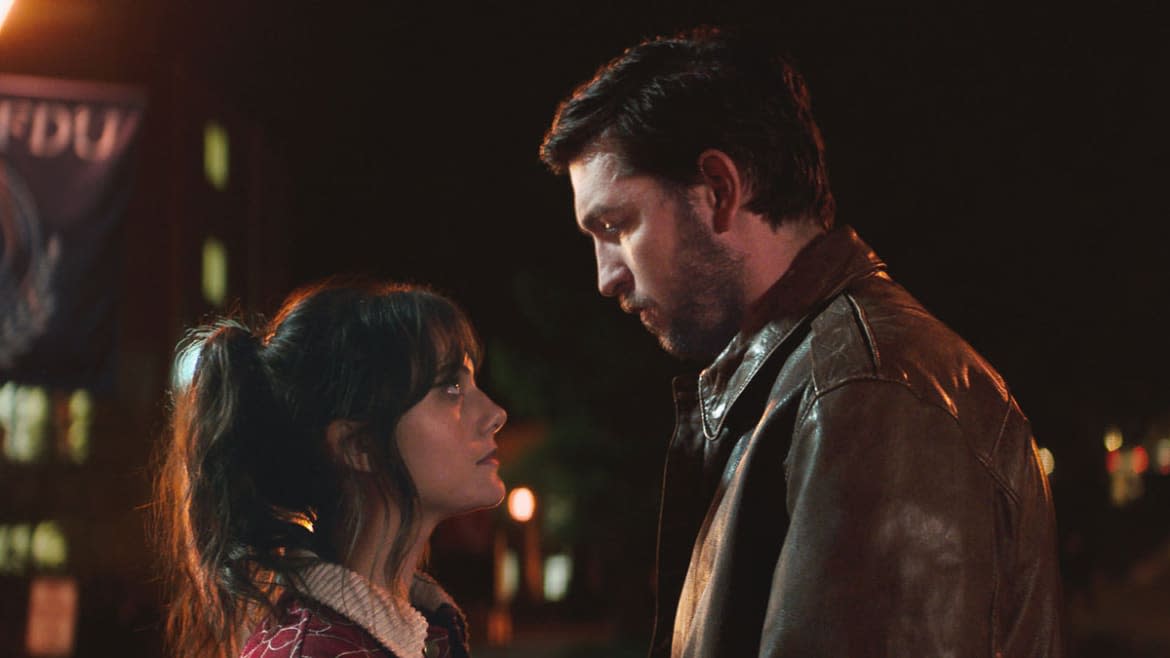‘Cat Person’ Devours Story’s Viral Discourse and Coughs Up an Unwatchable Hairball

- Oops!Something went wrong.Please try again later.
- Oops!Something went wrong.Please try again later.
When Robert walks into a movie theater in a college town, Margot, who’s working the concession stand, clocks him as he approaches the register. He “looks like the best friend in an Apatow movie,” she texts her friend, Taylor, smiling at her cleverness. “So tall, dark, and…problematic?” Taylor replies.
From the start, Cat Person is pleased with itself, telegraphing the obviousness of the broad, foreshadowing, and often patronizing supplemental material that the film adds, ruining almost anything that was interesting about its source material.
The frustrating thing is that Cat Person really should have and could have worked. It’s based on the 2017 short story written by Kristen Roupenian that appeared in The New Yorker, before turning social media, the blogosphere, the literary world, group texts, brunches, and toxic internet forums into a flaming inferno of discourse. When the firehose would finally extinguish one debate, it would blaze on to another area of the zeitgeist and wreak havoc again.
“Cat Person,” as it appeared in The New Yorker, was a story about a girl who dated a guy, narrating her private thoughts about their gender dynamics, power imbalances, chemistry, and her feelings about sex and romance in a modern world. Is he harmless and charming? Is he actually a predator? Is it unfair to assume the latter? Doesn’t she have to assume the latter? What role did she play in “leading him on”? Should the concept of “leading someone on” still exist anymore?

They were fascinating questions that internet culture metastasized into other tricky debates. Was the story good? Did questioning whether it was good reflect an inherent misogyny? After all, this style of writing is often heralded as brilliant when from a male perspective. There were questions about whether it was fiction or autofiction, and whether that mattered.
What about Margot, the narrator’s own privilege and her position of power? Maybe she was being unfair to Robert. She even fat-shamed him. Or did she? Maybe she was just saying what she thought, as unpleasant as that may be—which was the whole point of a story like this anyway.
It was all so very juicy. It was exhausting. It was perfect fodder for a Very Right Now movie.
Nicholas Braun, aka Cousin Greg from Succession, and Emilia Jones, the endearing breakout of CODA, were picked to play the leads, the epitome of exciting It Stars casting. It was to premiere at the Sundance Film Festival, where it easily ranked as one of the most-anticipated projects in the mountains. It was like movie greenlighting via A.I. It all just made sense.
Anne Hathaway’s ‘Eileen’ Is Dark, Explosive, and Has One Helluva Ending
And then it all went so very wrong, especially with a finale that careens wildly from where “Cat Person,” the essay, concludes. It may rank among the most unnecessary and ridiculous endings I’ve ever seen. After steadily bastardizing everything nuanced and ambiguous about all those questions listed above—demeaning the audience with over-explanation about how we’re supposed to interpret events—that ending is the final dump in the litter box.
But there are things about Cat Person that, at the start, really work.
Braun and Jones are fantastic. He is the perfect actor to raise the question of “is he bumbling and awkward at dating, or he is going to kill me” that fits with Margot’s paranoia, whether it’s necessary or ridiculous. And Jones telegraphs all the conflicted urges of someone who can’t fight off the feeling that, because she’s a young woman, she could always be in danger, while always wanting to give a possibly nice guy a fair chance.
Geraldine Viswanathan (Blockers) is especially great as Taylor, whose extreme feminism and militant insistence on boundaries fuels Margot’s constant unease—but is also needed so that she’s on guard and protects herself. There are several incredibly funny moments in the first act of the film, when there seems to be a tongue-in-cheek self-awareness about the short story and the deluge of discussion it caused. Far too quickly, though, that self-reference morphs into didactic explication.
Gael García Bernal Is Sensational as a Gay Lucha Libre Star in ‘Cassandro’’
Despite it never appearing in The New Yorker story, the film begins by flashing a Margaret Atwood quote on screen, to make sure we understand the lesson of what we are about to watch before it even begins. That’s one red flag. That this was the quote is another: “Men are afraid that women will laugh at them. Women are afraid that men will kill them.” At that point it wouldn’t have been a surprise if the director had burst through the screen Porky-Pig-in-Looney-Tunes style to say, “HEY GUYS, JUST MAKING SURE YOU KNOW WHAT THIS MOVIE IS ABOUT AND WHAT WE’RE TRYING TO SAY HERE!”
It’s not long into the film that Margot’s professor (Isabella Rossellini), an expert in the study of insects, delivers a not-so-subtle monologue to Robert as a threatening metaphor: Did you know, Robert, that when a male bee has sex with the colony’s queen, his penis falls off after and he dies? Or that it’s the females who work tirelessly to protect the queen and keep her alive? Robert, she says, do you understand what’s about to happen to you at the end of this movie? (OK, maybe I added that last one.)
Margot and Robert’s relationship begins over text, with great flirting banter. When they finally have their first date, it’s a mixed bag. She suddenly starts to notice the things she doesn’t like about him, like his nerdy obsession with Star Wars. Fleeting moments make her wonder if he’s a typical toxic douchebag, but then others endear him to her.
The subtext of the short story—the plight of a woman who must always wonder if this is a “bad guy”—is made plain as day, as Cat Person, the movie, interjects their interactions with bizarre, violent fantasies Margot has in which Robert traps and assaults her. All the complication of their dynamic is instead articulated and simplified in another imaginary scene, in which they undergo therapy and share their sides of the story of these triggering encounters.

Margot initiates having sex for the first time, but as the night goes on, tortures herself over whether she wants to. She debates if now, because she “started” things, she has to go through with it.
The sex is terrible. She decides she doesn’t want to see him again. Taylor steals her phone and sends him a clear text explaining as much. What’s left is waiting to see how he responds: if he really was a bad guy, or just another fling that ended awkwardly and they had been overthinking things.
In Cat Person, the film, nothing is left to interpretation. It speeds past where Roupenian ended her story, transforming the narrative into a full-blown horror film/revenge fantasy; Promising Young Woman by way of Final Destination. It feels wholly inappropriate and crass, an exploitation of thorny, yet worthwhile talking points into slasher entertainment that unmoors whatever grounding the movie had and rocket-launches into the stratosphere of implausibility.
It’s such a grand disappointment, one that will no doubt lead the Cat Person discourse into new lanes. If only it deserved it.
Keep obsessing! Sign up for the Daily Beast’s Obsessed newsletter and follow us on Facebook, Twitter, Instagram and TikTok.
Get the Daily Beast's biggest scoops and scandals delivered right to your inbox. Sign up now.
Stay informed and gain unlimited access to the Daily Beast's unmatched reporting. Subscribe now.

